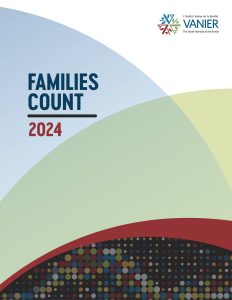Projects
Families Count
Vanier Institute’s new resource explores three decades of change, continuity, and complexity among families in Canada. Released during the International Year of the Family’s 30th anniversary, Families Count provides statistical portraits of families in Canada, highlights trends over time, and offers insights on what it all means for families and family life.
Chapter 18 – Women are more likely than men to work part-time to care for children
Managing time and money, two basic resources for families, often involves a trade-off. Full-time workers earn more money but have less time for unpaid work and caregiving activities, including self-care. Part-time work can provide more personal and family time but offers less employment income. It can also affect access to workplace benefits and may have implications for career progression.
Statistics Canada defines part-time workers as those who usually work less than 30 hours per week at their main or only job.1 In 2023, data from the Labour Force Survey (LFS)a showed that 18.0% of employees in Canada aged 15 and older worked part-time, up from 12.5% in 1976.2 Larger increases were seen among young people and older adults. Nearly half (49.4%) of younger employees aged 15 to 24 worked part-time in 2023, more than double the percentage in 1976 (21.1%). Among employed adults aged 65 and older, 41.3% worked part-time in 2023, up from 31.4% in 1976.
Women are more likely to work part-time than men, today and in the 1970s, but the gender gap has decreased. The gap is largest among workers aged 25 to 44. The percentage of women employees working part-time fell from 21.8% in 1976 to 15.6% by 2023.2 During the same period, the percentage of male employees working part-time increased from 1.5% to 5.9%.
Research has shown that women with family care responsibilities are more likely than men to take on work that fits the schedule of those responsibilities.3 Among part-time workers aged 25 to 44 in 2023, women (38.5%) were four times more likely than men (9.4%) to have cited “caring for children” or “other personal or family responsibilities” as their main reason for working part time.4 Although this was approximately the same as the percentage of women who cited these reasons in 1997 (38.0%), this was nearly three times higher than the percentage of men who did so (3.2%).
Working part-time can be due to personal preference and choice, or to circumstances such as an inability to work full-time or a lack of full-time job availability. Among all part-time workers aged 15 and older in 2023, 15.7% were involuntary part-time workers, compared with 29.2% in 1998 (which is down from a peak of 31.2% in 1997).4 This declined for both women and men in all age groups, with the biggest shift being among men aged 25 to 54. The proportion of men in this age group working part-time who were doing so involuntarily dropped from 56.1% in 1998 to 31.6% in 2023.
Why this matters
Working part-time can help parents allocate more time for their children, families, and other activities that are important to them. Studies show that it can also help to avoid work–family conflicts, as long as there is a supportive organizational culture at work.5 At the same time, part-time employment results in lower incomes, which can compromise families’ financial capacity and resilience.
Working part-time and earning less as a result may add financial stress to the family, especially when part-time work is involuntary. In the long term, access to parental benefits and pension plans, as well as the level of benefits received, depends upon hours worked and previous earnings. Part-time workers can sometimes face disadvantages concerning both their direct income and their eligibility for social security programs that can contribute to their family wellbeing.
Source: Statistics Canada. (2024, January 5). Table 14-10-0327-01 Labour force characteristics by sex and detailed age group, annual.2
Source: Statistics Canada. (2024, January 5). Table 14-10-0029-01 Part-time employment by reason, annual (x 1,000).4
Note
a Data from the LFS excludes the territories, persons living on reserves, full-time members of the regular Canadian Armed Forces, and persons living in institutions.
References
- Statistics Canada. (2023, April 21). Classification of full-time and part-time work hours. Statistical classifications. https://www23.statcan.gc.ca/imdb/p3VD.pl?Function=getVD&TVD=114437&CVD=114437&CLV=0&MLV=1&D=1 ↩︎
- Statistics Canada. (2023, January 5). Table 14-10-0327-01 Labour force characteristics by sex and detailed age group, annual. https://doi.org/10.25318/1410032701-eng ↩︎
- Oxfam Canada. (2016, March). Making women count: The unequal economics of women’s work. https://www.oxfam.ca/wp-content/uploads/2016/03/making-women-count-report-2016.pdf ↩︎
- Statistics Canada. (2024, January 5). Table 14-10-0029-01 Part-time employment by reason, annual (x 1,000). https://doi.org/10.25318/1410002901-eng ↩︎
- van Breeschoten, L., & Evertsson, M. (2019, March 1). When does part-time work relate to less work-life conflict for parents? Moderating influences of workplace support and gender in the Netherlands, Sweden and the United Kingdom. Community, Work & Family, 22(5). https://doi.org/10.1080/13668803.2019.1581138 ↩︎

Families Count 2024 is a publication of the Vanier Institute of the Family that provides accurate and timely information on families and family life in Canada. Written in plain language, it features chapters on diverse topics and trends that have shaped families in Canada. Its four sections (Family Structure, Family Work, Family Identity, and Family Wellbeing) are guided by the Family Diversities and Wellbeing Framework.
The Vanier Institute of the Family
94 Centrepointe Drive
Ottawa, Ontario K2G 6B1
[email protected]
www.vanierinstitute.ca

This work is licensed under a Creative Commons Attribution-Noncommercial 4.0 International license.
How to cite this document:
Battams, N., & Mathieu, S. (2024). Women are more likely than men to work part-time to care for children. In Families count 2024, The Vanier Institute of the Family. https://vanierinstitute.ca/families-count-2024/women-are-more-likely-than-men-to-work-part-time-to-care-for-children
